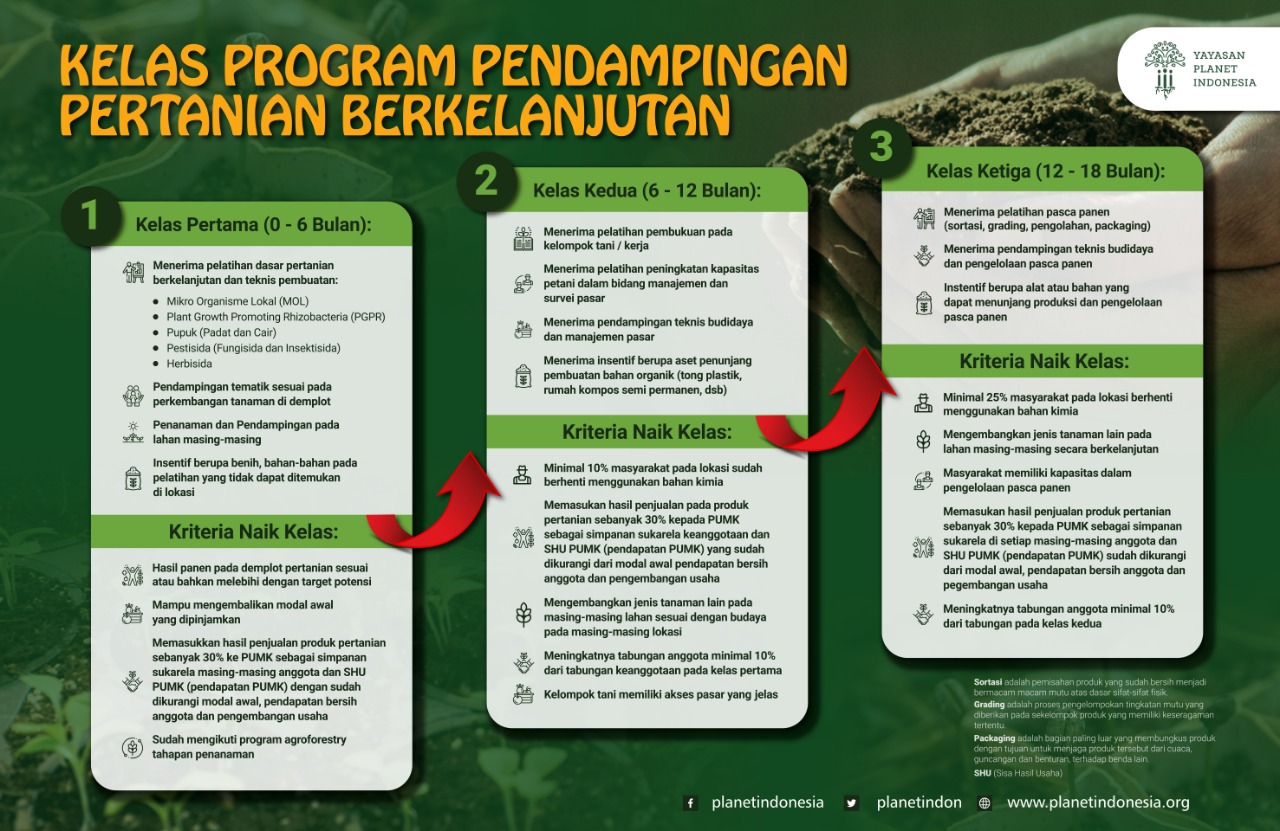Sustainable agriculture program and courses
The use of slash and burn agriculture, harmful pesticides and chemical fertilisers are devastating West Kalimantan’s soils and crop yields, creating a painful negative feedback cycle.
When farmers begin to face low crop yields from nutrient poor-soils and high rates of erosion, they try to turn bio-diverse forests into new farmlands in an attempt to regain what they lost through unsustainable farming practices.
By targeting these issues, we prevent environmental degradation and help communities rise above the rural poverty and financial insecurities that come with poor agricultural practices.
For 15 days out of every month, our agriculture team made up of Agung, Agato and headed by Dekky, head to the districts of Benkayang and Landak. There they work with the villagers to overcome the lack of access to farming technology, education and equipment to pursue a sustainable agricultural path.
The Agriculture program (which is similar to a schooling system made up of four grade levels) is one of the benefits we offer anyone who joins our Conservation Cooperatives from our partner villages in the Benkayang and Landak districts.
Together with rural farmers we work to implement leading practices, technologies, and information for climate-smart sustainable agriculture.
Using organic and semi-organic pesticides and fertilisers combined with crop rotation and mixture schemes, our farmers experience higher yields and richer soils without having to pay the high price for chemical alternatives.
Roughly 600 farmers attend our agriculture program every year.
One of our teams earliest innovations was a pesticide made out of organic ingredients such as lemongrass fragrant cloves and papaya leaves.
For caterpillar-type pests, you can use the tobacco extract and papaya leaves.
For aphids, fragrant lemongrass extract is an effective deterrent.
For pests such as grasshoppers, soursop leaf extract and papaya leaves are great.
For sucking pests such as starch and mosaic viruses, we use papaya leaf extract and betel leaf.
First, the ingredients are blended and crushed, then separated then boiled in water. The ingredients are brewed so that the extract from each ingredient can be removed.
Afterwards they’re placed in a large storage container where the solution can be filtered and used.
Initially the team will work with the villagers to prepare the pesticide.
From then on, the villagers have the knowledge to produce batches independently - to ensure they gain independence is one of the core considerations of our programs. Villagers are given access to various information and workshops, such as making organic pesticides or identifying local microorganisms, to improve their soil health and crop yields.
However, for sustainable farming to be effective, it requires the implementation of a comprehensive and impactful agriculture system which can be complicated and overwhelming if done all at once. This is why we’ve developed an agriculture course with four levels to ensure the process of change is as easy, affordable and comfortable for those who want to benefit.
After completing a grade, members move on to the next and we make direct contributions by providing additional agricultural assets farmers will need. Upon the completion of the fourth level, they are equipped with the techniques and equipment necessary to maintain such a system.
For example, the development of the pesticide is relatively simple and low-investment. Therefore it is one of the first activities conducted in the first-level which focuses on members receiving access to basic training in sustainable agriculture and manufacturing techniques.
To progress to the second class, members will have to fulfill certain requirements such as demonstrating an ability to apply what they have learned to generate larger crop yields.
Each class takes approximately 6 months to complete.
Most recently, we also began the initial trial run for a new farming initiative. We worked with our partner village of Umbo to implement a stingless bee hive system.
This initiative reflects our philosophy in practice particularly clearly. The honey has a high-market value and we only need to harvest a few initial hives (from outside of the nature reserve) because the hives can be split up upon maturation.
The bees and the revenue they will bring to the village is not only financially beneficial, it promotes sustainable practices too.
Chemical pesticides will kill the bees and smoke will force them to migrate, so villagers are incentivised to avoid slash and burn agricultural practices in the area or use harmful chemicals on their land - a need that should no longer be necessary thanks to the income generated by the bees and other Agriculture Program initiatives.
With climate change posing even greater threats such as longer periods of extreme weather, rural farmers will face droughts followed by floods and long periods of land saturation. It is imperative that they have access to climate smart farming methods that promote crop resilience.
Our Agricultural Program is an interesting and critical part our Conservation Cooperatives and we’re excited to see how our members benefit from it as they progress through the program and set off on their own.
We’ll continue to update you on the progress of our programs such as the stingless bee hives, so keep an eye out!



